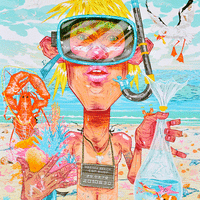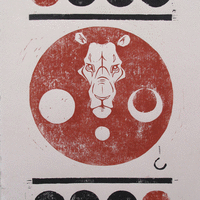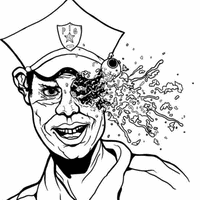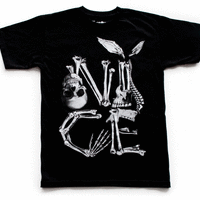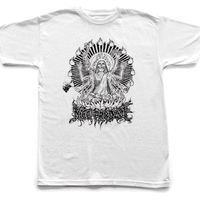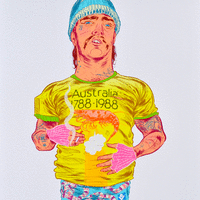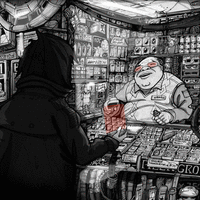Archive for the ‘LTRHDS’ Category
LTRHDS Video
Friday, June 4th, 2010Sporting a mighty beard.
Spirit Flyer – Mhak at Compound Gallery Portland
Wednesday, May 26th, 2010Mhak. June 3rd at Compound Gallery
[youtube]http://www.youtube.com/watch?v=a11pRUAMlb4&feature=player_embedded[/youtube]
[youtube]http://www.youtube.com/watch?v=qac4NPh85SE&feature=player_embedded[/youtube]
LTRHDS in Hidden Champion
Tuesday, April 6th, 2010The lads at Hidden Champion just sent me some copies of the latest Mag featuring the LTRHDS show.
Thanks Matsu!
I have a few extra copies so let me know if you want one.
LTRHDS book.
Friday, March 5th, 2010Available now on Niceproduce.com
26 Artist interviews and featured artwork
Limited edition of 400 prints.
Hard board embossed slip case
Printed on high grade paper by K.W Dogget.
Only $49 aus
LTRHDS Melbourne Opening
Wednesday, March 3rd, 2010Photos from the LTRHDS Melbourne launch are up on the Nice Produce FLICKRstream. Check them here.
Thanks to everyone for coming down.
LTRHDS preview
Friday, February 26th, 2010Jagi interview up from the LTRHDS Blog
Monday, February 22nd, 2010www.ltrhds.com
 Half a lifetime of 16-Bit video games, anime, fantasy art and prog rock, these are the elements that sit on the surface of James Greenaways work, but so much more lies just underneath and it’s this that has developed Jagi’s cult following over the last decade.
Half a lifetime of 16-Bit video games, anime, fantasy art and prog rock, these are the elements that sit on the surface of James Greenaways work, but so much more lies just underneath and it’s this that has developed Jagi’s cult following over the last decade.
James Greenaway first came to notice through the surreal promotional material he created for the his underground breakbeat and jungle parties, in the successive years he has developed into one of Melbourne’s most sophisticated emerging artists.
For more information check www.jagiart.com
Jagi’s artwork is based on the letter Q.

.
Your intricate landscapes remind me a little of old platform computer games. What sort of influence has gaming had over your work?
An enormous influence I would say. I spent most of my childhood sitting in front of the television playing Sega consoles. When Sonic the Hedgehog arrived in the early nineties, I remember how hypnotized I was by the blurring intricate landscapes as I watched the demo in numerous shop windows run though the first few levels.
Later I would come to understand the true sophistication of the design of the early Sonic games and how influenced by art deco design they were.
Having said that, when I look through old drawings I made when I was under the age of ten, the majority of them are landscapes from fictional video games I would imagine.
My first friend at school had a Commodore Amiga and I believe it triggered something in my imagination at a very early age. Even to this day I have a profound adoration of all imagery that came from the early decades of video gaming, everything from inappropriate box designs to extremely low-res and low-colour pixel art.
.
I’ll bet your Amiga friend had a copy of Shadow of the Beast.
Hmmm, I can’t remember… I do know that I soon got my own Amiga and I had a copy of Shadow of the Beast II, which was similar to the first installment, but had a darker, stronger atmosphere and more consistent graphics.
But yes, I’m familiar with the Shadow of the Beast series and their fantastic style and production values..
Incredible sound tracks too by David Whittaker and Tim Wright.
The worlds you create are ruled by fantastic feudal warriors and overlords. Do you flesh out each character’s full personality and background story in your head? Is there a mythic Jagi master narrative that envelops your creative terrain?
Interesting question. I wouldn’t say I flesh out ‘each’ characters full personality, or even at all.
When I design a character I want him/her to remind me of classic archetypes from old school manga and video games, such as the unwilling young hero, the nomadic bad-ass lone wolf character, the wise old mentor who is always touching up girls, the evil villain’s right hand man who near the climax of the story realizes the error of his ways and turns on the evil master, the evil master, the adorable flying furry turtle who turns out to be the last survivor of an ancient race of omnipotent god breeders…
So basically the ideas attached to any given character are loose but are profoundly awesome. I have come up with several ideas for story lines that could be good for films or video games, but that is usually a separate creative process to drawing and making art.
And yes there is a mythic Jagi master in this world. He is a shape-shifter and appears in different forms from picture to picture.
You can never be one hundred percent certain who he is, but generally he is depicted with some kind of godly power of creation over the landscape and creatures in the illustration.
.
.
 Jagi-Land seems like quite a hedonistic realm. Is it an escape from the uptight anxieties that govern life on the real world? Or are there darker currents running through your work?
Jagi-Land seems like quite a hedonistic realm. Is it an escape from the uptight anxieties that govern life on the real world? Or are there darker currents running through your work?
Yes I’d say it is an escape. Not just from anxieties of the real world but also from boredom with it.
I often day dream while I’m out and about and wonder why things cant be more interesting then they are. I’ve lived a very sheltered life and felt very out of place throughout most of it, so these landscapes are just depictions of the way I wish people and places could really be.
I don’t think there’s anything too dark in my artwork.. Sex and violence sure, but those aren’t enough to truly disturb people anymore.
You strike me as the sort of guy who just drew endlessly as a kid…Your penmanship is remarkably fine and precise. Have you given much thought to exploring other mediums? Can you imagine your characters somehow leaping out beyond the gallery frame?
Hehehe thanks. Yeah I’ve given thought to some other mediums.. Would love to do sculptures and figurines one day, but my main priority at the moment is in developing video games.
Although it involves the same techniques that I usually use for art (digital illustration), I think it’s a medium for storytelling and entertainment that is more powerful than film, music, or art, for the reason that it can incorporate all of the above into an experience like no other.
At the moment I have a storm of game ideas thundering around inside my head and I’m working towards making those dreams a reality and starting my own video game studio.
With any luck I will have a playable demo of a video game on display at my next exhibition.
Usugrow interview on LTRHDS blog
Sunday, February 21st, 2010The LTRHDS show will be launching this his Friday.
The LTRHDS blog has daily updates of some dope mini interviews with the artists, including the following interview with Usugrow.
Keep checking www.LTRHDS.com/blog for more.
.
You have described yourself as a Shinganist–an outsider. You seem to have adopted a very simple way of life… In consumer-driven Japan do you feel like an outsider? Or do you feel that your art is distinctly Japanese?
Certainly, I chose to live very simply in this consumer society… My lifestyle is like a cave person, digging up a potato and exchanging it for a necessary thing. However I don’t consider myself in this world as an outsider even though other people say so.
Sadly but also happily, I am surely a part of society. There are lots of crappy systems… On the other hand, there are also the systems that help us in society. Everything has two sides. You can’t just nibble here and there. I think it’s important to strive and fly the flag… I am not willing to run away from there.
You might get drunk with your mohawk hair, crying against society at a punk rock club, but you will be lining up at the ATM to get some cash and using a post office to send mail to your friend. Don’t you think it’s inconsistent? I am definitely a Japanese artist. You can tell that from my work and lifestyle, in a good and bad way.
 Your work tends to feature skulls and motifs of death, yet it has a great sense of peace and beauty to it. To what extent is this a reflection of your own philosophy towards being? Do you consider yourself to be a spiritual person?
Your work tends to feature skulls and motifs of death, yet it has a great sense of peace and beauty to it. To what extent is this a reflection of your own philosophy towards being? Do you consider yourself to be a spiritual person?
I used to draw skulls before because they just look cool, but things have changed recently. There is no more interesting motif than a skull, and I think they fit my philosophy. A skull is a symbol of death, but it also represents a life at the same time. A skull is not originally a skull from the beginning.
You lived, died and became a skull. I want to treat a skull more beautifully as a symbol of universal nature in everyday life. Isn’t it good to have a beautiful skull? I don’t enjoy the feeling of discomfort or consider it cool when a kind of skull appears in a horror movie or on the cover of a heavy metal album causing an unpleasant feeling.
Sometimes I like such a mood just for fun, but it’s not what I want. Also, regarding your question if I consider myself to be a spiritual person, I think everyone has a spiritual feeling and feels that in their everyday life.
For example, when you win a lottery, or when you get a phone call from someone that you are just about to ring. It totally depends on how you feel it… Some people think it’s spiritual and some people think that they are just lucky. But I am sure there are some senses that you can feel but can’t explain well.
 The subject of your work shares much in common with traditional tattoo art. Have you ever considered becoming a tattooist? Are you directly inspired by traditional Japanese tattoo art?
The subject of your work shares much in common with traditional tattoo art. Have you ever considered becoming a tattooist? Are you directly inspired by traditional Japanese tattoo art?
It’s a tough question. I was influenced by tattoos because I used to love traditional Japanese tattoos, Chicano style, primitive tribals and their history, so I’ve used it in my work before. I actually used to tattoo people sometimes over ten years ago, but I stopped a couple of years ago.
I don’t have good skills and my attitude towards tattoos became more clear. I don’t want to open any stores or become famous as tattoo artist.
Tattoos are a very personal thing and you’ve got to be responsible for the people you tattoo. It’s totally different from product design or fine art. You’ve got to work with one person responsibly and you’ve got to live a life that makes a person feel honored.
The thing I was most influenced by is not the design of Japanese tattoos, but the traditional spirituality. There are lots of tattoo studios, but all the tattoo artists that I admire are working consistently in a very quiet place, not at an open studio.
I would love to study and begin again ‘cause it’s very creative and I should be responsible for those people that I’ve tattooed before in my practice. So, if I ever begin again I wouldn’t want to tell anyone. This may sound annoying, but it’s not true that money solves problems.
 The punk scene had a profound influence over your work. Why do you think music has such an immense power over the way we think and relate to the world? What makes music so powerful and seductive?
The punk scene had a profound influence over your work. Why do you think music has such an immense power over the way we think and relate to the world? What makes music so powerful and seductive?
As I mentioned above about the spiritual thing… Music is quite spiritual as well. You feel so high when listening to a fast punk beat or heavy metal sound, and you are healed by top-forty cheap love songs that pop into your ears on the street.
We should leave it to the scholars to find out why this happens so we can all live everyday in a creative and positive way by devoting ourselves to music. People have been healed by the power of music since primitive times, so music will never die. Same thing with art. After all, we are all spiritual and primitive animals, I think.
 Your art is so precise and delicate… Are you a perfectionist? Are you one of those artists who will destroy a whole piece if one line is out of place? Or are you more relaxed and willing to let your pen guide your hand?
Your art is so precise and delicate… Are you a perfectionist? Are you one of those artists who will destroy a whole piece if one line is out of place? Or are you more relaxed and willing to let your pen guide your hand?
Sometimes I am a perfectionist, sometimes instinctive. Yes, I will destroy a whole piece if one line is out of place, depending on the piece. But this doesn’t happen every time. It totally depends on the work or its purpose. I think it’s necessary to make a choice in everyday life… Whether to believe in your intuition or do everything perfectly.
As for my work, I need perfect details in order to make the comfortable intuitive lines stand out. After all, everything has two sides and it’s important to know both sides, I think. And it’s my philosophy of my art and life.
Below are examples of artwork by Bene.
New on the LTRHDS blog. Phibs, Jago and Ghost Patrol
Wednesday, February 3rd, 2010Here’s the Jago interview.
for the rest check. www.ltrhds.com/blog

Bristol Based Mr Jago, a pioneer of the doodle, founder member of Scrawl Collective and a veteran in the street art movement and much respected among his peers.
Growing up in a small town, Jagos interests in art and design with influences from classic Marvel comics, graffiti and hip-hop culture have help forge his unique freehand style and distinct colour palette.
Jago has worked with some of the biggest international brands such as Nike, Puma, Xbox, Yohji Yamamoto & Boxfresh to name a few.
Mr. Jago joins the LTRHDS exhibition with his reinterpretation of the letter J
.
 .
.
 You’ve mentioned how your new works feature latent characters battling against the landscape that subsumes them. What does this struggle for definition represent? Is there a reason why your figures so overwhelmed and obscured by their surrounds?
You’ve mentioned how your new works feature latent characters battling against the landscape that subsumes them. What does this struggle for definition represent? Is there a reason why your figures so overwhelmed and obscured by their surrounds?
The figures are meant to represent us and our doings. I imagine our cities, pipes and power lines sprawling into the landscape like a giant alien parasite in a science fiction movie.
A synthetic entity gorging itself and expanding, with no Godzilla to slap it and tell it to bugger off back to its own planet. The battle in my recent pieces is me playing with the conflict between man and nature… looming figures scour their way across the landscape like storm clouds leaving destruction & noxious gases in their path.
.
.
.
 Your fantastic landscapes look like giant gassy nebula clouds… even though you have moved away from your anime-inspired art, tell us about the way that science fiction continues to inform your abstract style.
Your fantastic landscapes look like giant gassy nebula clouds… even though you have moved away from your anime-inspired art, tell us about the way that science fiction continues to inform your abstract style.
It seems that in the space of my short lifespan a lot of what was science fiction has already become science fact.
We are constantly bombarded with the evidence of our impact on the environment, so the worlds I imagine in my work could be our own. A common landscape in science fiction (old and new) is a planet sapped of all its resources, a toxic and hostile environment in which mankind is left to scratch out an existence.
The clouds in my paintings are the imagined fallout from the damage done but like oil and fossils the clouds could also be us.
..
..
You seem to be  working a lot with triptychs lately – why this choice? Has the sprawling nature of your work been a gradual development or did you make a conscious choice to start painting on a larger scale?
working a lot with triptychs lately – why this choice? Has the sprawling nature of your work been a gradual development or did you make a conscious choice to start painting on a larger scale?
The triptychs came about simply from me switching from canvas to paper. After several frustrating attempts at fitting my marks within the dimensions of a single sheet I chose to adopt the same attitude
I would when approaching a wall piece: simply by spreading out and adding more paper, I gave myself more space to work within, and this ended up leading to a slightly more panoramic look to my landscapes.
.
 Working in a call center did you ever think you weren’t going to make it as an artist? How close did you come to throwing it all in, and what kept you going?
Working in a call center did you ever think you weren’t going to make it as an artist? How close did you come to throwing it all in, and what kept you going?
I think if anything it was the call centers that lead to me having a career. The longer I spent in them the more it became apparent that I would lose my soul (and my marbles) if I stayed in that line of work.
There was no time to talk to your fellow ‘slaves’ and not much fun to be had either, so the only tactic to stay sane was to draw. I worked with my friend Will Barras, and we would pass doodles back and forth to try and make each other laugh, often ending calls prematurely!
This went on for a while until Will made the leap and got out to pursue his career in illustration.
Before long I took Will’s lead and used my evenings to scan drawings onto my Mac at home and then colour them up; and after shopping them around to record labels and magazines with little success, my big break came when Ric Blackshaw saw some flyers I’d been doing for club nights in Bristol.
He included some of these designs in the first Scrawl book. Before long Ric was getting enquiries about my work from some pretty big clients. It was the confidence boost I needed to leave the ‘battery farm’ vowing never to return. When things are tight the memory of my time in the call centers helps to keep things in perspective.
..
 Was Rolf Harris really one of your earliest artistic influences?
Was Rolf Harris really one of your earliest artistic influences?
I grew up with Rolf’s happiness on the TV. It was his large scale speed paintings that I admired the most.
At school I was told I was good at art but like most children wasn’t very confident with someone looking over my shoulder as I worked. Rolf just got on with it. I loved the way he would bang on the colour not once appearing to worry that his painting could go wrong. He was the king!






Koan
![]() Cognitive Dissident.
Cognitive Dissident.







































